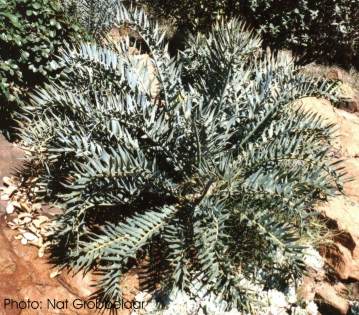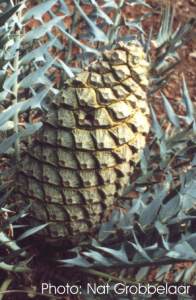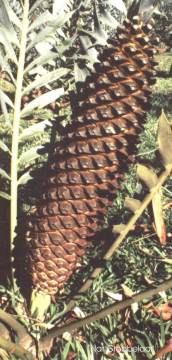Encephalartos horridus
Encephalartos horridus (Jacq.) Lehm.
Family: Zamiaceae
Common names: Eastern Cape blue cycad, blue cycad
Introduction
This cycad has been described as one of the most unusual of all the South African species. It has been very over-collected in the past, but sufficient quantities are now available in nurseries to reduce some of the pressure on wild populations.

Description
Description
Two forms are found in nature: a dwarf form and larger more robust, typical form. The only difference is in the stem and leaf size, both are shorter in dwarf form.
It is a small, low-growing cycad up to 800 mm long and 300 mm across. The trunks branch freely, forming dense clusters of overlapping/entangled blue-green foliage, with between 4 and 8 stems clustered together. No other blue-leaved cycad rivals the intense blue of this cycad's foliage. The very attractive colouring and rigid curling of the leaves, gives it a rather unique look.

Both sexes bear a single cone per crown, males occasionally two in December - January. Mature cones are bluish green in colour, the male more blue than the female. The female cone is egg-shaped. Seeds are pale red to carmine in colour. The male cone is sub-cylindrical, narrowed at both ends. Leaves do not droop during coning as with some other cycads.
Conservation Status
Status
This cycad is assessed as Endangered by the Red List of South African plants. Contact your local conservation authorities for permit details.
Distribution and habitat
Distribution description
Endemic to South Africa, this cycad is restricted to the Port Elizabeth and Uitenhage districts of Eastern Cape. This is an almost frost-free area with an annual rainfall ranging from 250 mm-650 mm. This cycad occurs in various habitats such as Karoo scrub, sourveld, deep fertile soil and open rocky ridges. It is found in full sun. The climate is hot in summer, cool to mild in winter with frosts a rarity.
Derivation of name and historical aspects
History
The specific name horridus means Latin 'bristly, dreadful, horrible' from Latin, an appropriate name for this species with its heavily armed leaves.
Ecology
Ecology
African cycads have few enemies in nature itself. Animals such as porcupines and baboons can cause damage to the stem and cones, because of their feeding habits. Neither of these animals are a large threat to cycad populations. Insects that can harm cycads are larvae of certain moths and seed-eating snout beetles or weevils.

Insects are immensely important to the continued survival of cycads, since they are responsible for the pollination of these plants, carrying pollen from one plant to another. Seed dispersal is accomplished through birds, monkeys, baboons and in some cases even elephants. They eat the fleshy outer cover and discard the toxic seed to germinate where it falls. Cycads can reproduce through suckers that grow from the mother plant.
Growing Encephalartos horridus
Grow
This is a very hardy, adaptable, relatively slow-growing cycad and suited to temperate and subtropical regions. It is best not planted too closely to paths, requires full sun and excellent drainage, not too much water; tolerates light to moderate frosts and needs slightly acidic soil. In cultivation male cones will often cone several times a year in succession and the dwarf nature of the plant may disappear.
Propagation: From seed or removal of suckers which transplant readily, but for your first cycad rather buy a seedling from a nursery. They grow a lot easier and faster than those grown from seed. Experience is also needed to grow from suckers.
Pests to be on the lookout for in southern Africa are:
Leaf parasites range from moth larvae to plant lice and can all be rather well controlled with contact insecticides. Cone parasites attack the cones of the cycads, mostly beetles or weevils. This is combated by spraying the cones with insecticides just before the cones become sexually mature and for some weeks after. Be very careful before spraying and make sure the beetles on the plants are actual pests and not pollinators.
Stem/trunk and root parasites: larvae from certain beetles have been known to infiltrate the trunks of cycads causing rot to set in, which if untreated can kill your cycad. Treatment: Systemic insecticides and in addition, carefully cut out any infected trunk tissue, then sterilize and seal the trunk to stop any fungal and bacterial infection.
Certain ant and termite species are known to attack the roots and underground part of the trunk, causing damage and leaving the plant vulnerable to fungal and bacterial infections. Various insecticides are available on the market to combat these problem insects.
Fungal infections: various fungicides are available to fight these problems. Infected and even old dry leaves should be removed and burned to stop any spores from germinating. Bacterial infections are a more difficult matter and to date, nothing on the market has proved to be really effective. For information on pests in the rest of the world, please contact your nearest nursery or cycad expert.
References
- GIDDY, C. 1974. Cycads of South Africa. Purnell, Cape Town.
- GOODE, D. 1986. Cycads of Africa. Struik, Cape Town.
- GROBBELAAR, N. 2002. Broodbome. Met spesiale verwysing na die Suider-Afrikaanse soorte. Pretoria.
- HILTON-TAYLOR, C. 1996. Red Data List of southern African plants. Strelitzia 4. National Botanical Institute, Pretoria.
- JONES, D.L. 1993. Cycads of the World: ancient plants in today's landscape. Reed, New South Wales.
- KREMPIN, J. 1990. Palms and cycads around the World. Horwitz Grahame, Australia.
Credits
Lou-Nita Le Roux
Lowveld National Botanical Garden
April 2003
Plant Attributes:
Plant Type: Shrub, Tree
SA Distribution: Eastern Cape
Soil type: Sandy, Loam
Flowering season:
PH: Acid, Neutral
Flower colour:
Aspect: Full Sun
Gardening skill: Average
Special Features:
Horticultural zones











Rate this article
Article well written and informative
Rate this plant
Is this an interesting plant?
Login to add your Comment
Back to topNot registered yet? Click here to register.